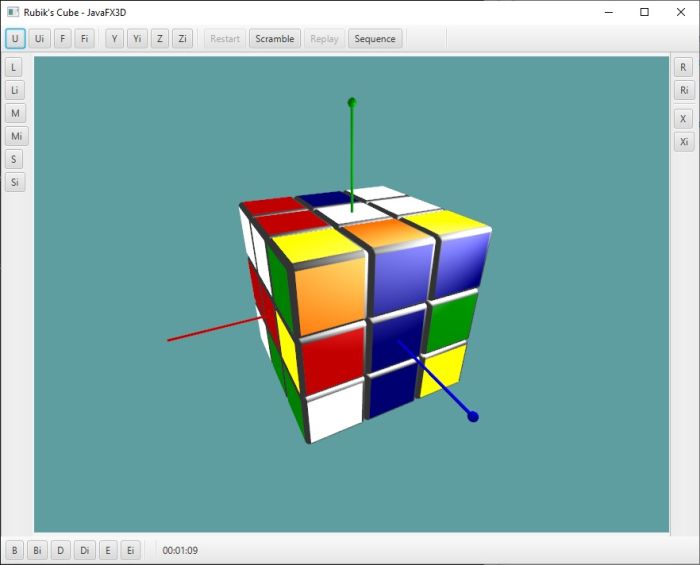A JavaFX-based desktop application for playing with a 3D model of the Rubik's Cube by rotating layers or the whole cube (as originally described upstream by José Pereda.)
For a version that can build native images for desktop, Android and/or iOS platforms, see rubiks-cube.
This fork adds the Gradle and Maven wrappers and build scripts to compile and package this desktop application.
The Gradle or Maven build script produces a RubikFX application, for running in standard JVM/JavaFX 11+.
The build scripts can also produce stand-alone native executables, using
GraalVM native-image utility,
for common platforms - Windows, Linux, and MacOS (untested).
To build and run the RubikFX application in standard JVM environment, execute the Gradle run task:
gradlew run
By default JavaFX 3D will use GPU hardware acceleration for rendering. If hardware acceleration
is not available, i.e. the RubikFX application shows an empty window, the software acceleration
feature can be used instead (but slow!) by setting the prism.forceGPU system property to true:
gradlew run -Dprism.forceGPU=true
To create an executable uber jar which includes all dependencies for current platform:
gradlew uberJar
and the resulting RubikFX-1.0.0-SNAPSHOT-no-deps-<platform>.jar file should be created in build/libs directory,
and can be executed directly with the java command, e.g. in a Linux box:
java -jar build/libs/RubikFX-1.0.0-SNAPSHOT-no-deps-linux.jar
java -Dprism.forceGPU=true -jar build/libs/RubikFX-1.0.0-SNAPSHOT-no-deps-linux.jar
(or if building on a Windows machine:
java -jar build\libs\RubikFX-1.0.0-SNAPSHOT-no-deps-win.jar
java -Dprism.forceGPU=true -jar build\libs\RubikFX-1.0.0-SNAPSHOT-no-deps-win.jar
)
RubikFX can be compiled to a stand-alone native executable, e.g. producing RubikFX.exe in Windows,
using the GraalVM native-image utility.
The link shows how to set up GraalVM and its native-image utility for common platforms.
Gluon also provides some setup details
for GraalVM native image creation.
The Gradle build script uses gluonfx-gradle-plugin from Gluon to build the native executable from Gradle with GraalVM.
Once the GraalVM prerequisites are set up for the current platform,
run the nativeBuild task to produce a native executable:
gradlew nativeBuild
The nativeBuild task will take a while to finish, resulting in a native executable file at, e.g. in a Linux box:
build/gluonfx/x86_64-linux/RubikFX
and can be run directly:
./build/gluonfx/x86_64-linux/RubikFX
./build/gluonfx/x86_64-linux/RubikFX -Dprism.forceGPU=true
(or if building on a Windows machine:
build\gluonfx\x86_64-windows\RubikFX.exe
build\gluonfx\x86_64-windows\RubikFX.exe -Dprism.forceGPU=true
)
To build and run the RubikFX application in standard JVM environment, execute the Maven javafx:run task:
mvnw javafx:run
By default JavaFX 3D will use GPU hardware acceleration for rendering. If hardware acceleration
is not available, i.e. the RubikFX application shows an empty window, the software acceleration
feature can be used instead (but slow!) by setting the prism.forceGPU system property to true:
mvnw javafx:run -Dprism.forceGPU=true
To create an executable uber jar which includes all dependencies for the current platform:
mvnw package
and the resulting rubikfx-1.0.0-SNAPSHOT-no-deps-<platform>.jar file should be created in
target directory, and can be executed directly with the java command, e.g. in a Linux box:
java -jar target/rubikfx-1.0.0-SNAPSHOT-no-deps-linux.jar
java -Dprism.forceGPU=true -jar target/rubikfx-1.0.0-SNAPSHOT-no-deps-linux.jar
(or if building on a Windows machine:
java -jar target\rubikfx-1.0.0-SNAPSHOT-no-deps-win.jar
java -Dprism.forceGPU=true -jar target\rubikfx-1.0.0-SNAPSHOT-no-deps-win.jar
)
RubikFX can be compiled to a stand-alone native executable, e.g. producing RubikFX.exe in Windows,
using the GraalVM native-image utility.
The link shows how to set up GraalVM and its native-image utility for common platforms.
Gluon also provides some setup details
for GraalVM native image creation.
The Maven build script uses gluonfx-maven-plugin from Gluon to build the native executable from Maven with GraalVM.
Once the GraalVM prerequisites are set up for the current platform,
run the gluonfx:build task to produce a native executable:
mvnw gluonfx:build
The gluonfx:build task will take a while to finish, resulting in a native executable file at, e.g. in a Linux box:
target/gluonfx/x86_64-linux/RubikFX
and can be run directly:
./target/gluonfx/x86_64-linux/RubikFX
./target/gluonfx/x86_64-linux/RubikFX -Dprism.forceGPU=true
(or if building on a Windows machine:
target\gluonfx\x86_64-windows\RubikFX.exe
target\gluonfx\x86_64-windows\RubikFX.exe -Dprism.forceGPU=true
)
The project can be imported as-is to any IDE such as Eclipse, IntelliJ IDEA, etc, which understands a Gradle and/or Maven project structure.
